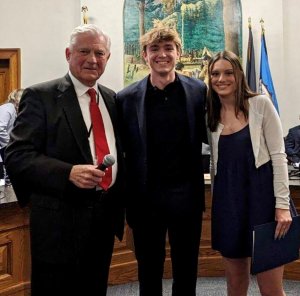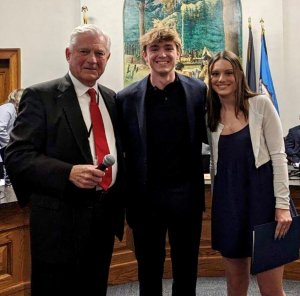The Sembrich Launches “Stravinsky and the Premiere of the Century”
BOLTON LANDING — The Sembrich has launched “Stravinsky and the Premiere of the Century,” the seventh presentation in its 20/20: Virtual Visionaries summer festival.
The latest installment of the Alfred Z. Solomon Innovator Series transports The Sembrich audience back to the night of May 29, 1913, the groundbreaking premiere of The Rite of Spring with vintage images, video clips, and an article on the auspicious night by distinguished Stravinsky scholar, Charles Joseph.
The program features an article adapted from a chapter of Joseph’s 2011 book Stravinsky’s Ballets. Charles M. Joseph is Professor Emeritus of Music and the former Dean and Vice President of Academic Affairs at Skidmore College. He is the author of two other books, Stravinsky and Balanchine, the winner of an ASCAP Award in Biography, and Stravinsky Inside Out. He lives in Saratoga Springs.
The program also includes the eleven-minute opening segment of the 2009 film Coco Chanel and Igor Stravinsky, which re-creates The Rite of Spring premiere at the Théâtre des Champs-Élysées in Paris.
“This re-enactment, with its sweeping camera angles and multiple perspectives from stage, audience and orchestra pit alike, conveys the energy and excitement of that first performance,” says The Sembrich’s Artistic Director Richard Wargo. “And is as close as we can come to imagining ourselves as eyewitness to the momentous event. We’re truly grateful to film producer Claudie Ossard and to author Charles Joseph for sharing this wealth of material with us, allowing for this latest exciting entry in our Alfred Z. Solomon Innovator Series.”
“Stravinsky and the Premiere of the Century” can be found online at TheSembrich.org/online. The Sembrich is located at 4800 Lake Shore Drive, Bolton Landing. For more information, visit www.TheSembrich.org or call 518-644-2431 or email: This email address is being protected from spambots. You need JavaScript enabled to view it.
100 Years of Women’s Right to Vote Celebrated on Broadway
“The right of citizens of the United States to vote shall not be denied or abridged by the United States or by any State on account of sex.”
- 19th Amendment to the U.S. Constitution: Women's Right to Vote (1920)
SARATOGA SPRINGS — A celebration marking Women’s Equality Day and the centennial of the formal certification of the 19th Amendment to the U.S. Constitution was held across the country on Aug. 26.
In Saratoga Springs, a 12-hour gathering was staged at Palette, a female-focused coworking space and café on Broadway, where a full slate of events kicked-off with an 8 a.m. morning meditation, and featured a series of Q & A sessions and panel discussions with local political office-holders, healing energy practitioners, business leaders, and activist, among others.
The 19th amendment gave women the right to vote following several decades of struggle for women’s suffrage – a movement founded in the mid-19th century and spearheaded by people like Elizabeth Cady Stanton and Lucretia Mott, Susan B. Anthony and Elizabeth Cady Stanton.
While certified as an amendment in 1920, historians also point to the 1965 Voting Rights Act some 45 years later as finally outlawing discriminatory voting practices that restricted black men and women from voting.
A new interactive website celebrating historic New York State suffragists was also launched in conjunction with Women’s Equality Day that includes historic and biographical information, and an interactive map with cemetery and gravesite locations about women and men who were active in the suffrage movement. That website can be found at: womenandthevotenys.com.
SPAC, Saratoga Shakespeare Company Celebrate Beethoven, Present World Premiere Saturday
SARATOGA SPRINGS — A new audio play providing a portrait of Ludwig van Beethoven at a time of personal crisis will celebrate its world premiere on Aug. 22.
SPAC is celebrating the 250th anniversary of the composer's birth with Beethoven 2020 and “Testament” - written by Damian Lanigan and co-produced with the Saratoga Performing Arts Center will have its World Premiere streaming on both SSC and SPACBeethoven.org from 8 p.m. Aug. 22 until 11:59 p.m. on Aug. 23.
“Testament” is a portrait of Ludwig van Beethoven grappling with the loss of his hearing and emerging from his suffering to write one of the greatest symphonies of all time.
Directed by Marcus Dean Fuller and featuring recordings by The Philadelphia Orchestra, “Testament” had originally been planned as a live performance at SPAC’s Spa Little Theater as part of the SSC’s 2020 summer season, but in response to COVID-19 restrictions on public gatherings, the company pivoted to an audio presentation that Fuller describes as a “musically driven audiobook.”
Charter Change: Back on the Ballot
SARATOGA SPRINGS — On Election Day, city residents will be asked to consider a change in the only form of governing that Saratoga Springs has known since its inception as a city in 1915.
In 2017, the last time a citizen-led City Charter referendum proposed change, the measure was defeated by a razor-thin margin of 4,458 - 4,448.
The current “Commission” form of governing features five council members – one mayor, plus four commissioners heading the departments of Public Safety, Public Works, Finance, and Accounts, respectively. Each council member is responsible for administering their own department as well as serving as legislators. In this council of five, each of whom is elected to two-year terms, decisions are made by majority rule.
The “Council-Manager” proposal calls for replacing that “Commission” form in favor of one that includes a mayor – elected by the voters of the city at large, and six members elected from city wards by the voters of those specific wards. Those six wards are to be comprised of equal voting population.
That city council of seven would then appoint, set the salary for, and hire a City Manager. The idea is that residents would be represented through the ward system, and the manager held to accountability via the city council.
A new group opposing the charter change proposal staged a gathering in Congress Park this week. They call themselves Saratoga Works and include co-chairs Connie Woytowich and Jane Weihe, and steering committee members Chris Obstarczyk, Courtney DeLeonardis, Janice Partridge, Jay Partridge, George Cain, and Joe Dalton.
Weihe said a change in Saratoga Springs’ current form of government would be risky during a time of a pandemic and subsequent economic crisis, and that this “expensive version of charter change” would politicize neighborhoods by dividing them into wards.
Those financial concerns are specifically related to what the overall costs could be should the plan be implemented; even though some city deputy or assistant salaries would be saved, new workers would still need to be hired to conduct the work the current city employees are doing, she argued.
“We don’t know what it will cost. This is more of a concept than a plan,” she said. A website, saratogaworks.org, was launched in conjunction with the group gathering.
Gordon Boyd is a member of the citizen group proposing the new charter for the city. Last summer, a group of 41 residents circulated the petitions necessary to place the proposition on this November’s ballot. A total of 1,565 registered voters signed the petition to put the proposal on the ballot.
“We’ve got a chance to start fresh coming out of this public health crisis,” said Boyd, adding that an information website is anticipated to be launched sometime around Labor Day, heading into the election season. If approved by voters, the measure is expected to take effect in January 2022.
The concept of a Commission form of government was founded in Galveston, Texas in 1901 after a storm ravaged the city, killing more than 5,000 people and creating the need for a useful way of post-disaster governing. It proved to be an efficient measure as well as a popular one. By 1912, 206 cities in 34 states had followed suit. Saratoga Springs adopted the commission form of governing shortly after it was incorporated as a city in 1915. Since its popularity in the early 20th century, however, many cities have since switched to other forms.
Timing is Everything: From Everyday Citizen to Public Safety Commissioner During a Crisis
SARATOGA SPRINGS — In January, Robin Dalton took office as city Public Safety Commissioner – the first woman to hold the position which oversees, among other things, the overall operation of the police and fire departments.
She grew up in Manhattan “in a really loving, happy home, and attended classes at the Chapin School, an all-girls school on the Upper East Side that lists among its alumnae Jackie Kennedy Onassis, Vera Wang, and N.Y. Mets owner Joan Whitney Payson. “Ivanka Trump was two grades below me,” Dalton says. Shortly after earning a Bachelor of Arts degree in Government from Cornell University, in 2007 Dalton relocated to Saratoga Springs where she lives with her husband and their four children.
FROM LOCAL RESIDENT TO CITY GOVERNMENT
In 2012, Dalton began digging into city politics and observing council meetings. “To me it was very important to have experience in Saratoga and get involved in the community in a way to really understand the spirit of the city so I can represent the people who live here to the best of my potential. So, I really waited until I was ready to take this on because I knew it would be challenging.
“One of the best things about it was I perceived partisanship as not being a factor in how the City Council was voting. It didn’t seem people were making politically based decisions. The decisions were being made as for what’s best for the city. And I think that’s also been my happiest revelation over these past seven months. I don’t think there’s been a single moment where anyone has invoked my party to persuade me to vote one way or another. It’s a non-issue,” Dalton says. “Partisanship doesn’t have any role in how the City Council votes. And to me that’s a really good thing. That’s been really awesome.” Seven months on the job, Dalton sat down this week to talk about the status of several pressing city issues in this most unusual year.
COVID
When the city declared a State of Emergency in March, the city’s Emergency Management Plan directed the public safety commissioner lead a team to address the emergency. “That was a moment when our form of government was at its best,” Dalton says. The city’s Commission form of governing – which charges each commissioner with different responsibilities, yet equal political power was born specifically from emergency when it was implemented in Texas, in 1901 as a reaction to the Galveston hurricane.
“I was also fortunate to have a City Council that was supportive of how I was sourcing and disseminating information, which was taking it from our governor. It was disappointing to me we didn’t have a leader of our country who led by example – handling it with science and data rather than partisanship, so I was going to stick to the guidelines laid out by Governor Cuomo. I would say I love what he’s doing right now. Will I love what he’s doing six months from now? A year from now? Probably not, but that’s not going to prevent me from saying he’s done a great job handling the virus.”
A member of the Republican Party, she is unafraid to step outside any pre-conceived limitations regarding party and is something she says she was upfront about when first interviewing with the city GOP Committee. “I went through a list of things I knew they weren’t necessarily going to be happy about: I’m pro-choice, I’m pro-immigrant – but I wanted to be clear upfront about what I stand for.”
POLITICIZING A VIRUS
“Unfortunately, everything has taken on a whole new meaning. It’s not about your health necessarily, it’s about what you stand for, what party you’re with. I think that’s really sad and destructive. It’s been divisive but at the end of the day all I care about is that the city is as healthy as possible and simultaneously that our economy is strong. There is an incredible importance in both and we’re not here to put one above the other.”
SCHOOLS
“We have models we look at and we’re working very closely with the hospital. We are expecting positive cases to go up because kids are coming back to school. We need to predict these things. I don’t think it’s going to take us back to where we were at our peak, which was about 10% positive cases. Right now, we’ve dropped to under 1% which is fantastic. There’s a huge mental health component and our children have suffered immensely. We’re trying to give kids a little bit of normalcy.”
ADDRESSING THE NEED FOR A FIRE/EMS STATION TO SERVE RESIDENTS OF THE EAST SIDE
“We have done a site plan and needs analysis of the Henning Road location and put out an RFP for a design firm. We had planned on moving on this aggressively, but when the pandemic hit everything got paused.” The question now is how best to move forward in a tough economic climate. To that end, the city is exploring state aid and grant possibilities to assist moving forward. “I think this is a smart way to handle it that doesn’t put us in a situation of it being a financial liability. But we’re setting ourselves up such that we can use money from the state to complete the project and deliver for our east side residents their emergency medical needs while also not putting the city in a precarious financial position.”
HOMELESSNESS AND THE NEED FOR A PERMANENT CODE BLUE EMERGENCY SHELTER
“With this pandemic and this ensuing financial collapse, we’re going to be seeing a lot of people who are in distress in terms of keeping a roof over their head. And (homelessness) is not a one-size-fits-all problem. There are some people who are drug-addicted, people who have mental issues, people who have no interest in finding or seeking shelter and have established a lifestyle outside, downtown. That works for them, but it’s not something that as a city the residents want to tolerate. If you go over to the Woodlawn parking lot you can see it almost every day; it’s almost an encampment and really a struggle for the neighbors there. So, we’re addressing that – but homelessness is not something that can be solved by law enforcement. It can be solved by having community partners working together in the spirit that the Saratoga Collaborative to End Homelessness is working in. You need the county on board, you need all the social services to be on board and everyone needs to come at this issue wanting to get rid of all the roadblocks and challenges that are in place, to get people into housing and work through them in difficult and sometimes scary ways. Without that, I don’t know that there is a fix for this issue.”
“We also have this enormous need for a year-round shelter, and we don’t have that place right now. We’re just pushing people from one area of the city to the other, going around and around and it’s an enormous waste of time, energy, resources and ultimately isn’t helping the people who we want to help. So, It’s incredibly frustrating and incredibly challenging. That’s really a critical part of this problem. We have to have this permanent, year-round facility, and then it comes down to whose responsibility is it to financially provide this. I am very committed to solving this problem, but I also know the roadblocks and challenges ahead of us are significant.
RALLIES AND PROTESTS AND ISSUES OF RACE
“Emotions have been running extremely high – not just about race but of all these contributing factors, all over America. I can’t recall a time when people have been this traumatized and have had such heightened emotions and reactions.
“For any kind of significant change to happen it needs to happen as a community, not just as law enforcement. This is a Saratoga Springs conversation. We all need to be addressing how the experience of being white in Saratoga is very different than being black in Saratoga. (Our officers) have reached out to Black Lives Matter protesters locally, taking a knee with protestors, walking arm-in-arm with them. They’ve exercised incredible professionalism and the only thing they want is for people to exercise their First Amendment rights to free speech and the right to gather and protest and to be able to do that in one piece. The absolutely last thing I wanted was for anyone to be arrested and any kind of violence to break out.
“I will be very candid and say I don’t think having a Back The Blue rally was an appropriate choice at this time. I thought it was a bit tone-deaf and likely to make the challenges of addressing Black Lives Matter and racism and bias larger and make people louder and angrier and divide people more than it would bring people together. I’m looking at this in a bigger picture context. Because of this moment of time that we’re in, I really do feel we need to be focusing on how being black in Saratoga is extremely different than being white in Saratoga, and that’s not something people are necessarily ready to acknowledge, to work toward something better.
“I believe in my department, I believe in our professionalism. I also understand the families who have someone working in law enforcement wanting to show their support for what these officers have been doing, but unfortunately in the national context that immediately gets misconstrued or associated with racism or fascism or all sorts of political extremism. I know locally that wasn’t the intention at all, but it all led up to this horrible, stressful, awful moment where these two groups of people are screaming at each other, (figuratively) ripping each other apart, and it was so sad to watch because there’s no reason why one group should be pitted against another group. I think we all want a lot of the same things. To see how both groups expressed how emotional and angry they were was just a sad state of affairs.
“Believe in law enforcement. Believe that black lives matter. I think it’s perfectly normal to have both those things live in the same person. But what I’m seeing is people thinking you can’t be both these things, and that’s disturbing and sad. I think we’ll get through it, but we have a lot of healing and work to do.
IN 12 MONTHS TIME
“I hope we return to some sense of normalcy in terms of our behavior and how we interact with one another. I’m hoping that our health is good and that our economy is recovered. Life as we knew it. But, with this new and real threat of a Pandemic it’s going to be a challenge. We still don’t know everything we need to know about it. We still don’t have a vaccine. There are all these variables that need to be answered before we can say with confidence that we’re good, we’re safe.”
Live - Lake George Music Festival “Drive-In” Series to take place in September
LAKE GEORGE – Accomplished world soloists, graduates of Juilliard, Curtis, Yale, Rice University, Carnegie Mellon, and members of major orchestras such as the Baltimore Symphony Orchestra, Malaysian Philharmonic, and the Buffalo Philharmonic will perform at the Lake George Music Festival “Drive-In” Series Sept. 19-20.
Attendees are encouraged to watch the performance from their car/truck, or bring a chair to place within arm’s length of their vehicle. Performances will be visually enhanced with large screen video and audiences will have the option of listening to the amplified performance, or tuning into a high quality and synced audio feed (FM radio) to play through their car’s sound system.
The program will feature Beethoven Quintet for Piano and Winds, Schubert “Trout” Quintet, Rubinstein Octet Op.9, and more.
The event takes place at the Charles R. Wood Park - Lake George Festival Commons, at 7:30 p.m. on Saturday, Sept. 19 and Sunday, Sept. 20.
From organizers: We will begin parking cars at 6 p.m. Cars will be parked every other car and in single rows to comply with physical distancing recommendations. We encourage guests to arrive with members of your household. Early entry will not be permitted. We encourage attendees to use the restroom prior to arrival; however, we will have sanitized restrooms on site. The entire process will be “touchless.” Those who order their passes online will have no contact with festival staff or musicians. We will simply check you in and direct you where to park. Cars will be directed to vacate the premises immediately after curtain and will not be allowed to linger.
Passes for each concert sold at $25 per vehicle. Vehicles may contain the legal limit of individuals. Passes will be sold online in advance (recommended) or at the gate. Concert programs will be distributed digitally on the large screen or available to view on your Smartphone or Tablet.
For more information and to purchase passes, go to: lakegeorgemusicfestival.com.
SARATOGA SPRINGS - The Thoroughbred Retirement Foundation (TRF) will host a re-imagined “TRF BBQ at the Barn” summer fundraiser 4 – 7 p.m. Tuesday, Aug. at The Saratoga Winery. This year’s BBQ will be carry-out with a twist.
Guests will drive thru the grounds to enjoy a TRF “Experience” with miniature ponies, racing celebrities, goodies for the kids, and a special appearance by Joey, the TRF Herd Ambassador, who will be returning to Saratoga from the TRF Second Chances Program at Wallkill. The event will feature BBQ from Barnsider BBQ in Lake George; a TRF Specialty cocktail created by the Winery; and locally made pies from Mourningkill Bake Shop. Items will be individually ordered online for carryout (only). Proceeds from the event will benefit the hundreds of TRF horses in the organization’s national herd.
The Saratoga Winery is located at 462 NY-29 in Saratoga Springs. Tickets and donation options available by visiting the TRF website at www.trfinc.org/event/bbq-at-the-barn-2020/ .
Founded in 1983, the Thoroughbred Retirement Foundation is a national organization devoted to saving Thoroughbred horses no longer able to compete at the racetrack from possible neglect, abuse and slaughter. As the
oldest Thoroughbred rescue in the country, the TRF provides sanctuary to retired Thoroughbreds throughout their lifetime.
For more information visit: www.trfinc.org.
Mark Lawson Antiques Lands $20,000 Sale on Chinese Bronze Censer
SARATOGA SPRINGS – Local antiques specialist and auctioneer Mark Lawson secured an exceptional result in the sale of an antique Chinese bronze censer for his long-time client Jim Kambrich, the recently retired
anchor for WNYT Channel 13 News.
The bronze censer had come down through Kambrich’s family from his grandparents and was among the items Jim and his wife Susan sold through Mark Lawson Antiques in an effort to downsize and move after Jim’s retirement.
The censer was about 11 inches tall and took the form of a “foo dog,” the mythical Chinese guardian lion that typically stands in front of Imperial palaces. An initial sale price for this piece was $300 to $500. When the gavel finally fell, the sale price was $20,000. Remarkably, this kind of thing happens regularly with the sale of good quality Chinese antiques to a new and growing population of native Chinese collectors.
Mark Lawson Antiques is currently cataloguing its next sale, a live auction with online-only bidding scheduled for Aug. 1, 2020. Live previews will be held on July 30 and 31. Please see marklawsonantiques.com for details.
Free Online Event: Women-Owned Small Business Federal & NY State Certification Webinar
The U.S. Small Business Administration’s (SBA) Syracuse District, and SCORE present an update webinar on SBA’s Women-Owned Small Business (WOSB) and New York State’s Women-Owned Enterprise (WBE) certification programs.
The free online event will take place 10 a.m. on Thursday, Aug. 6.
SCORE is a nonprofit association dedicated to helping small businesses get off the ground, grow and achieve their goals through education and mentorship for more than 50 years.
The Women-Owned Small Business (WOSB) Federal Contracting certification process is changing, and the new certification will be required as of Oct. 15. Applications can be submitted using the new process starting in July. Becoming certified for the WOSB program means your business is eligible to compete for WOSB Federal Contracting Program set-aside contracts.
The webinar will feature Stephen Barr - Business Opportunity Specialist, SBA Syracuse District Office, and Kayla Perry - Program Manager, North Country Procurement Technical Assistance Center (PTAC).
Register for the webinar at: score.zoom.us/webinar/registerWN_5f5sKYCpQQWZYGQe68fqw
Funded in part through a Cooperative Agreement with the U.S. Small Business Administration. All opinions, conclusions, and/or recommendations expressed herein are those of the author(s) and do not necessarily reflect the views of the SBA.
City Proclamations Honor Solomon Northup, AIM Services, CDTA
SARATOGA SPRINGS — This week, city Mayor Meg Kelly read three proclamations. The first honored the legacy of Solomon Northup.
Northup, a free black man living in Saratoga Springs, was in March 1841 tricked by two con artists who had promised him work in New York City but instead transported him further south where he was sold into slavery. It is where he would remain for the next 12 years.
At the time, Northup was 32 years old and lived with his wife, Anne, and their three children in Saratoga Springs - first on Washington Street, then relocating around the block to the United States Hotel. He was engaged in seasonal work at the busy hotels during summers and secured engagements as a violin player during the winter months to make ends meet.
“I was walking about the village of Saratoga Springs, thinking about where I might obtain some present employment…on the corner of Congress Street and Broadway near the tavern still kept by Mr. (C.B.) Moon,” Northup recounted in the book he wrote about those years, titled: “Twelve Year a Slave.”
The strangers promised Northup $1 for each day of service plus $3 per show in addition to cover his traveling expenses back to Saratoga Springs. He was enslaved for 12 years.
Saratoga’s reputation as a resort town had already been established by the mid-1800s. The black population in Saratoga Springs grew from less than 100 in the 1830s to nearly 300 by mid-century. Many were attracted, as Northup was, by the hope of job opportunities.
“I passed the days and nights. I was heart sick and discouraged. Thoughts of my family, of my wife and children, continually occupied my mind. When sleep overpowered me, I dreamed of them - dreamed I was again in Saratoga - that I could see their faces, and hear their voices calling me,” Northup wrote.
Although northern-based blacks were said to be free, many were kidnapped and brought South where they would be sold. In 1800, all of Saratoga County had 358 slaves. By 1810, the figure was 107. At the time of Northup’s abduction 30 years later, census figures list a total of four slaves in the entire state of New York. By comparison, southern states like Georgia showed 280,000; South Carolina more than 320,000 and Virginia recorded nearly a half million slaves among the population in the 1840s.
Solomon Northup Day, launched by local resident Renee Moore, was first designated in Saratoga Springs in 1999. A plaque commemorating Northup was fixed outside the Saratoga Visitors Center on the corner of Congress Street and Broadway.
Northup’s book was published shortly after his release in 1853. In 2013, a film adaptation of Northup’s book, titled “12 Years A Slave,” garnered numerous awards, including an Oscar for Best Picture of the Year.
A second city proclamation honored the upcoming 50th anniversary of the Capital District Transit Authority on Aug. 1 and noted that in its highest ridership year CDTA had secured 17.1 million riders.
A third proclamation expressed appreciation for the work conducted by AIM Services, Inc., who have residential and community-based services to people with disabilities since 1979 in Saratoga, Warren and Washington counties, and was read in advance of next week’s 30th anniversary of the Americans with Disabilities Act.
Talking About Statues in Congress Park? Perhaps Some Consideration Should Be Made for Music Man Francis Johnson
SARATOGA SPRINGS — In 1821, renowned composer, musician, show man and bandleader Francis Johnson was hired to come to Saratoga and entertainer summer visitors at Congress Hall.
The Philadelphia-born fiddle player had adapted his musical skills to the newly designed keyed bugle which earned him high prominence on the early 19th century concert circuit, providing him bookings all across North America as well as overseas.
Born a free black man, Johnson led his band in Saratoga Springs for more than 20 years - between 1821 and 1843 - missing only the 1840 season. He played to overflow crowds that invited extended bookings.
"The groves and spacious halls of Saratoga resounded with the notes of this enchanting bugle and violin," reads one anonymously penned local review of the era, praising Johnson and his band's performance of "music from all the recent operas, together with waltzes, gallopades, marches and quicksteps."
Johnson performed twice a day in Congress Park and alternated evenings at Congress Hall and the United States Hotel. His compositions included pieces titled in honor of the region - "Saratoga," "Congress Hall," and "Ballston," among them.
He entertained families with cheerful marches, livened up parties with cotillions - brisk, lively dance tunes, enjoyed by audiences that included James Monroe and John Quincy Adams, Andrew Jackson and Martin Van Buren.
For his band, Johnson hired what was regarded as some of the best black musicians of the early 19th century, and shortly before his death in 1844, he staged what are believed to be some of the first integrated concerts in America.
The bandleader was recognized in Saratoga Springs on July 20, 1978 – which was declared Frank Johnson Day, in a proclamation issued by the city of Saratoga Springs and signed by Mayor Raymond Watkin.































 How to resolve AdBlock issue?
How to resolve AdBlock issue? 









